In today’s construction industry, it’s all about working smarter, not harder. Thanks to an abundance of power tools, the era of hammer and nail is virtually extinct. Even when there aren’t any sockets or power available, you can bet there’s a long list of battery operated power tools ready to make short work of the job.
But whether you’re just assembling furniture and installing fixtures or giving your kitchen a complete overhaul, there’s one important tool you’ll have to rely on for both small DIY tasks and mammoth projects – the best cordless drill under 100 in the UK. Cordless drills have come a very long way; some of today’s models are so powerful and advanced they could put their corded counterparts to shame.
What’s more, they charge quicker, stay powered for longer, and pack one helluva punch when called upon. Their unique advantage is that they offer accessibility in areas where wired tools can’t reach. Be it a socketless basement or a new shed far out in the property, cordless drills give you all the reach and flexibility you need to work safely. So, what kind of cordless drill are you looking for?
Types of Cordless Drills
- Drill/Driver – This is the most popular, basic type of drill used by most people to both drill and drive into wood, plastic, and metal.
- Hammer drill – These do pretty much everything a drill driver can do. However, they have a hammer function that provides more power to drill into tough materials like stone, brick, and masonry.
- Rotary hammers – Bigger, stronger, heavier duty version of the rotary hammer drill used by professionals.
- Impact drivers – Characterised by a smaller, lighter profile, impact drills are ideal for driving and loosening screws and nuts.
Key Features and Considerations When Buying a Cordless Drill
a. Battery
Today’s range of cordless drills are powered by Lithium ion batteries. These are smaller batteries that are infamous for keeping their charge for longer when not in use. They’re also quick to charge and much lighter so users can avoid hand fatigue. Be sure to check out the charge as well and how long it takes to fill her up. If you have a demanding project, you can always grab a spare battery.
b. Speed and Variable Control
While the average budget model has only one speed, others have several ranging from 300RPM all the way to 1000 RPM. Higher speeds mean users can get the job done quicker, but some materials may require a more gentle approach. That’s why having a cordless drill with variable speed control is very important.
c. Power
Cordless power tools are measured in battery voltage; the higher the voltage, the more punch your drill has. Typically, the voltage of most cordless drills is between 6 to 18V. The more powerful 18V drills are suited for professionals who use the tool on a daily basis. However, people looking to use the drill for simple DIY tasks won’t need as much voltage – but it doesn’t hurt either.
d. Drill Bits
Selecting the right bit for the job and material type will make the drilling that much easier. The good news is that most cordless drills have interchangeable drill bits for driving, drilling, screwing, boring and many more. You may want a keyless chuck system for tool-less changing of bits.
The Best Cordless Drill under 100 Reviews
1. Bosch PSB 1800 Cordless Combi Drill
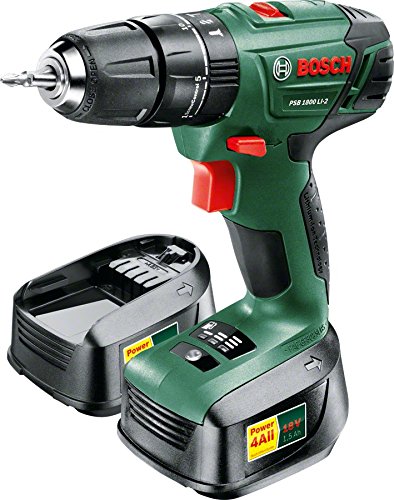
The PSB 1800 combi drill from Bosch is a 2 speed, cordless drill designed to deliver high power levels for professional fitting projects. Whether it’s regular driving or impact drilling, the 1800 is packed with advanced technology to make the job easier. One of those is Bosch’s innovative Syneon Chip that helps efficiently manage the battery coordination with the gears for optimum power output and maximum endurance. This drill also features a two speed gearbox that offers better power transfer and smoothness even in low speeds.
This two speed gearbox stands out with a wide array of pre-selectable torque settings. Users get as many as 20 settings to get the best results for different applications. Speaking of different applications, you’ll need several different bits for each job. Bosch integrated a keyless chuck feature on the 1800 to allow for tooless bit changing. Likewise, professionals working in dark areas will appreciate the built-in LED light that provides adequate illumination of the drilling area. The manufacturer included a second battery so that professionals can have a back up on those longer, tougher projects.
What I like about it:
- Bosch Intelligent Syneon Chip
- 2 18V lithium ion batteries
- Keyless chuck offers tooless bit changing
2. DEWALT LXT COMBI DRILL
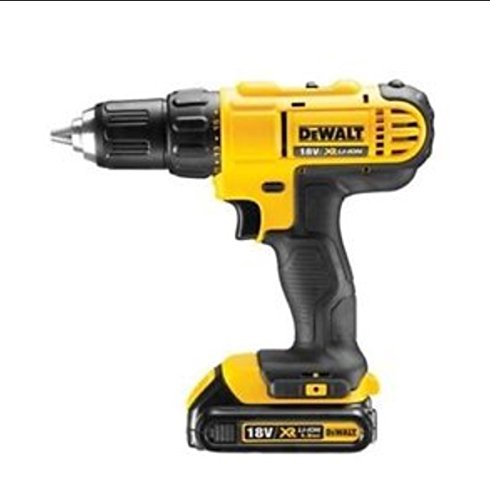
Upping the amperage to something that professionals can work with, the 18V combi drill from Dewalt is a beast. This drill weighs in at over 3Kg which makes it a tad weighty, but the overall feel is balanced and consistent even in rugged use. Unlike most combi drills, the LXT seems more built for drilling. It even comes with 3 different drill functions depending on the kind of task you’re doing. They include a screwdriver, hammer drill, and drill.
Just like other high end models on this list, the LXT also has a 2 speed variable gearbox to provide users with more torque versatility. Since the LXT is built for professionals and serious DIYers, it can hit a max drilling capacity of 25mm in wood, and 13mm in both metal and masonry. Dewalt included a myriad of drill bits to go with the LXT; and they can all be effortlessly interchanged courtesy of a 13mm keyless chuck. The 1.3 Ah rechargeable battery takes about an hour to fully charge.
What I like about it:
- Reliable Dewalt construction
- Rapid charge battery
- Comes with heavy duty Dewalt carrying case
3. BLACK+DECKER BDCHD18K Combi Hammer Drill
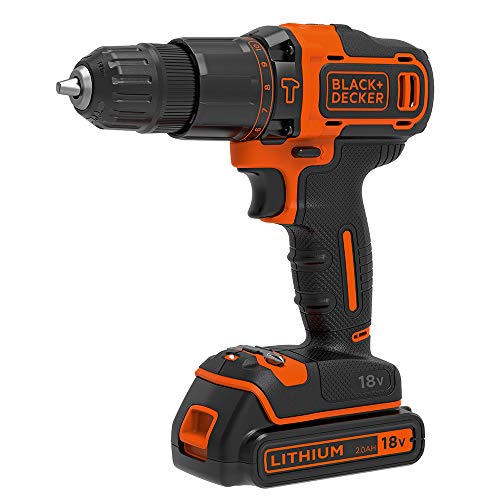
Featuring a 10 position clutch and a 2 speed gearbox, Black & Decker have offered users a mid range, fairly priced power tool with an abundance of features. The BDCHD18K Combi Hammer Drill is a solid feeling tool that excels at both high speed boring as well as those delicate driving duties that require a bit more precision. This means that users will feel as comfortable using it for drilling into masonry as they would hanging shelves and curtain fittings.
The BDCHD18K Combi Hammer Drill may be compact, but it packs an incredible punch no matter what surface you’re working with. For those who require a bit more power, the manufacturer paid special attention to the hammer function which delivers 21000 BPM. This can be used in tandem with the 0-1400 rpm variable speed on the drilling applications to get through demanding jobs. If you’r e working in dark or poorly lit areas, the 18K comes with an LED light to brighten up the work area.
What I like about it:
- Light and Compact 1.1kg body
- 11 different torque settings
- Hardwearing carrying kit box
4. Draper 83574 Cordless Hammer Drill
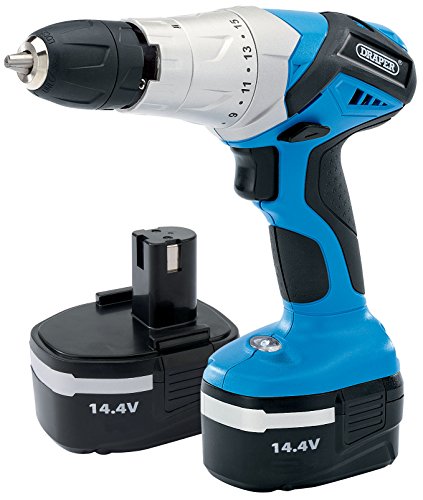
Like most homeowners in the UK, you probably just want a drill to help you with small tasks around the house. If you’re up for some occasional DIY projects that won’t be needing as much power or frequency as the professionals, then the Draper 83574 Cordless Hammer Drill could really save you some money. This particular drill from the family run company known as Draper has one of the lowest price tags on our list.
But that doesn’t mean that it is any less efficient compared to its more costly counterparts. The 14.4 v battery delivers enough power to bore through wood, aluminium, steel, and even masonry. However, you’ll notice it takes anywhere between 3-5 hours to fully charge it with the included 230V charger. Fortunately, there’s also an included extra battery to avoid any unwanted interruptions. Draper definitely designed the 83574 for easy use – but that didn’t stop them from including 15 settings for the variable speed control.
What I like about it:
- Ideal power for medium household tasks
- Simple, minimalist user friendly design
- Comprehensive variable speed control
5. MYLEK 18V Cordless Drill Driver
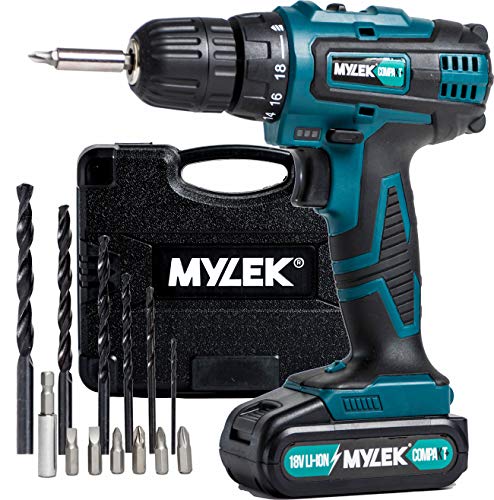
Are you a DIY enthusiast looking for a value drilling kit? Mylek has just the thing for homeowners and budding professionals looking for a budget friendly, all inclusive power tool and accessory kit. The MYLEK 18V Cordless Drill Driver is a reliable, multipurpose drill that is ideal for a wide range of tasks around your home or garden. The manufacturer designed the drill with user comfort and versatility in mind.
The drill comes with a 13 piece accessory kit that not only lets users carry out a broad range of applications, but also slots quite nicely in the included carry case. For something so affordable, it’s worth noting that the drill comes with an 18V Li-Ion battery. All this power combines with 19 different torque settings for variable speed to give users a smooth drilling experience in different materials. The drill bits are easily interchangeable and all work in both forward and reverse for tightening and loosening. As a security feature, the MYLEK Drill Driver makes use of a safety quick stop brake function to reduce the chance of injury.
What I like about it:
- Value pack 13 piece accessory kit
- 18v Li-Ion battery
- Unique electric safety brake system
Frequently Asked Questions
Q: How to charge a cordless drill without a charger?
It can be dangerous to charge your cordless drill without a charger, so remember to take the utmost care.
You can do it, using batteries and connectors, but this requires some level of electrical awareness, and it can be dangerous and can lead to injury or damage to your drill.
Your best bet is to get hold of another charger as quickly as you can, or better still, have a supply of spare chargers so that you are never without a charger in your times of need.
If you absolutely need to finish the job and can’t wait to get another charger, you can charge your cordless drill using AA batteries.
- For a 12V drill, you will need 8 AA batteries, two wires and some electrical tape. Connect the first two batteries positive end to negative, and tape them together. Continue with the rest of the batteries until they are all connected.
- Next, attach one of your wires (use plastic coated wires with the metal insides exposed, so that you can manipulate the wires without getting hurt) to the end of the battery with the positive end exposed, then attach your second wire to the negative end.
- When attaching your makeshift battery to your drill battery, make sure that you attach the positive to the positive and the negative to the negative, the opposite of what you were doing with the batteries.
- You can hold or tape the wires onto the drill battery, but you should always supervise it and remove the batteries immediately if you smell anything strange.
It will take some time to charge the drill enough to finish the job, but it should get you through those times when you really need to finish a job quickly.
Q: How to use a cordless drill?
A cordless drill is fairly easy to use. It is ergonomically designed so that you can just grip it in your hand, and pull the trigger with your forefinger to make the drill work.
There is a switch that makes the drill change direction, this is usually located above the trigger switch.
There are different torque settings you can select based on how far you want the drill to drill into various different materials.
- To drill INTO something, the direction should be set to clockwise.
- To REMOVE a screw from something, set the direction to anticlockwise.
- To change drill bits, open the chuck that holds the bit in place. This is easily done; simply hold the chuck in one hand and twist it with the other.
- For drilling large diameter holes, or for bigger screws, use the slowest speed which has the highest torque. Medium speed is for intermediate work, and the fastest speed is used for drilling small holes quickly.
Q: What is the best voltage for a cordless drill?
The voltage you need for your cordless drill will depend on the use you are thinking of using it for. Cordless drills tend to range from 10 to 24volts.
For a light duty cordless drill, drilling holes into plasterboard, wood or drywall, 12 volts or less will be suitable.
For heavier duty work, such as metal and ceramic applications, a voltage up to around 14 volts should be fine.
A higher powered model will mean a harder working tool, which will generally be heavier than their lower voltage counterparts, so bear this in mind when you are looking for a cordless drill.



